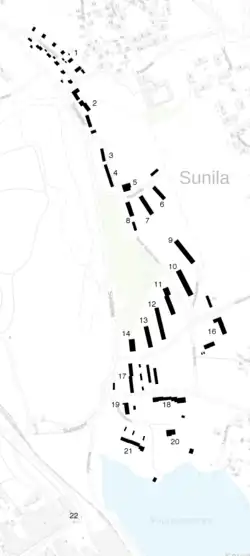Sunila, Kotka
Sunila
Bärnäs | |
|---|---|
Kotka subdivision | |
 Factory manager's residence ('Kantola') | |
 Map of Sunila, with Aalto-designed buildings indicated | |
| Coordinates: 60°29′56″N 26°57′21″E / 60.4989°N 26.9559°E | |
| Country | |
| Region | Kymenlaakso |
| Sub-region | Kotka-Hamina |
| Municipality | Kotka |
Area | 0.3 km2 (0.1 sq mi) |
| Population (2012) | c. 1,100 |
| Postal code | 48900 |
| Subdivision number | 37 |
Sunila (Swedish: Bärnäs) is a district and an industrial complex in the town of Kotka, on the shore of the Gulf of Finland in eastern Finland.
Sunila pulp mill
In 1938, a pulp mill was opened there on the site of an earlier sawmill, operated by the Ahlström paper and pulp manufacturing group through its subsidiary Sunila Oy. Since 2009 part of the Stora Enso group, the Sunila plant remains in operation as the oldest surviving sulfate pulp mill in Finland.[1]
The design for the factory complex was commissioned from the Finnish architect couple Alvar and Aino Aalto, on the suggestion of the Ahlström chief executive at the time, the industrialist Harry Gullichsen. It has been described as the most beautiful factory building in the world, as well as "one of the most notable 20th century industrial buildings in Europe" by ERIH Association.[2][3]
Residential area
To accommodate the factory staff, an adjacent residential estate was built, also designed mainly by Aalto. The estate comprises over 20 buildings, mostly low-rise apartment blocks, as well as terraced houses and a detached house serving as the factory manager's residence, 'Kantola', which was the first of the residential buildings to be completed. The buildings were constructed over two decades from mid-1930s to mid-1950s.[4]
The residential buildings are located in a natural wooded area, intended to promote the health and well-being of the residents, and were designed to fit in with the nature and the contours of the land. They were noted at the time for their modern, socially-conscious, progressive design ideas, and high quality of architecture and construction.[1][4]
The Sunila area is the largest Aalto-designed entity ever built.[4]
Some of the original buildings have already been demolished, such as the cooperative retail store built in 1937 and pulled down in 2006.[1]
In 2024, Stora Enso sold the Sunila site to a property development company, Aalto Development Oy, remaining in the factory as a tenant.[5]
Recognition
The Sunila factory milieu has been designated and protected by the Finnish Heritage Agency as a nationally important built cultural environment (Valtakunnallisesti merkittävä rakennettu kulttuuriympäristö).[1]
In 1993, the site was included in the DOCOMOMO modern architecture register.[1][6]
In 2025, Finland proposed Sunila to be added to the UNESCO World Heritage Sites collection as part of 13 Aalto-designed sites.[7]
References
- ^ a b c d e "Sunilan tehtaat ja asuinalue (Sunila factory and residential area)". RKY.fi (in Finnish). Finnish Heritage Agency. Retrieved 27 July 2025.
- ^ "Sunila pulpmill and residential area". European Route of Industrial Heritage. Retrieved 27 July 2025.
- ^ "Aino & Alvar Aalto's Sunila". Visit Finland. Retrieved 27 July 2025.
- ^ a b c "Sunila pulp mill and residential area". Alvar Aalto Foundation. Retrieved 27 July 2025.
- ^ "Stora Enso divests Sunila site to AALTO Development". Stora Enso. 8 November 2024. Retrieved 27 July 2025.
- ^ "Sunila Industrial and Residential Area - Alvar Aalto". DOCOMOMO Finland. Retrieved 27 July 2025.
- ^ "Alvar Aallon suunnittelemalta alueelta Kotkassa saa asunnon 20 000 eurolla – nyt odotetaan päätöstä, joka voi muuttaa kaiken" (in Finnish). Yle. 24 February 2025. Retrieved 27 July 2025.
External links
Further reading
- From Decay to Maintained Heritage: the Case of Sunila, a Residential Area in Finland in the Anthropology of Architecture journal